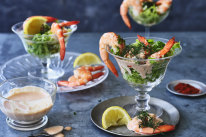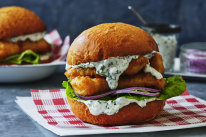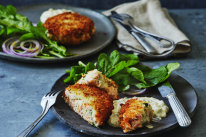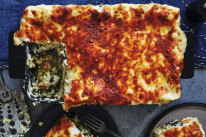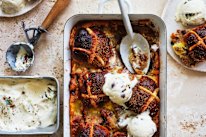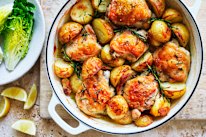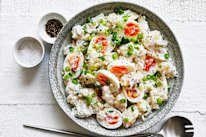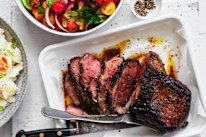Adam Liaw’s step-by-step guide to making the perfect chicken parmigiana at home
You won’t find it in Italy. But in Australia, it’s vying for national dish status, whether you call it parma or parmi.
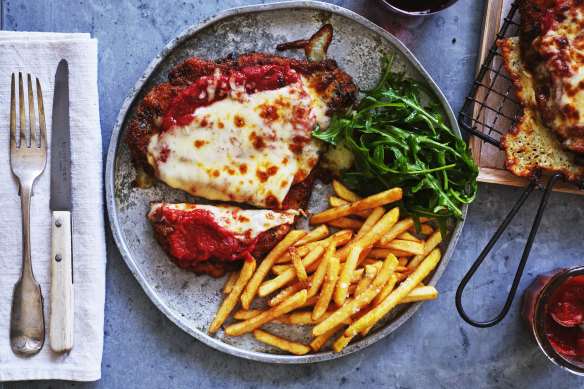
Parmigiana came to Australia with post-war migrants from Italy as a crumbed eggplant dish. It wasn’t until the 1980s that the schnitzel version (sometimes veal, but more commonly chicken) started to creep into our pubs. Today, the chicken parmi (or parma) is an Australian icon. It even mounts a case for being considered our national dish. Here’s how to make the best chicken parmigiana.
Ingredients
4 chicken breasts (about 180g each)
salt and freshly ground black pepper
250g (1 cup) plain flour
2 tsp chicken stock powder
4 eggs
150g (3 cups) dried breadcrumbs
2 tbsp finely shredded parsley
45g (½ cup) freshly grated parmesan
500-750ml vegetable oil, for shallow frying
225g (2 cups) grated mozzarella
hot chips, to serve
green salad leaves (dressed with lemon juice and a little oil), to serve
Tomato sauce
2 tbsp olive oil
1 small brown onion, finely chopped
1 garlic clove, finely chopped
700ml tomato passata
1 tsp dried oregano
1 tsp salt
3 tbsp finely chopped parsley
Method
Step 1
For the tomato sauce, heat the olive oil in a medium saucepan over medium heat and add the onion and garlic. Cook for about 5 minutes until fragrant and the onion is translucent. Add the passata, oregano and salt and simmer covered for about 15 minutes. Remove from the heat and stir through the parsley.
Step 2
Butterfly each chicken breast by cutting it horizontally almost all the way through, and then opening up the chicken breast like a book. Pound the chicken between two pieces of paper towel to about 1cm thick. Season well with salt and pepper and set aside for 15 minutes. Combine the flour and chicken stock powder in a tray. Beat the eggs with a few tablespoons of water in a separate tray, and combine the breadcrumbs, parsley and parmesan in a third tray.
Step 3
Heat the oil in a deep-sided frying pan to 170C. Take a skewer and pick up one chicken breast, transfer to the flour and coat lightly. Dust off any excess flour and transfer to the egg mixture, again using the skewer. Lastly, coat the chicken in the breadcrumb mixture, pressing the crumbs onto the chicken and shaking off any excess. Fry each schnitzel for about 2-3 minutes on each side until golden brown, skimming off any breadcrumbs that float into the oil. Remove the schnitzels from the oil and drain on a wire rack, propping up one side of the rack so the schnitzels drain on an angle.
Step 4
Heat your oven’s overhead grill to as hot as it goes. Spread each schnitzel generously with the tomato sauce, then scatter generously with the mozzarella. Grill until the cheese is golden. Serve with chips NEXT to the schnitzel (not under it) and a well-dressed green salad.
Notes
Parma or parmi?
I’m only going to devote three sentences to this point. As a South Australian, I say “parmi”, but as an Australian, I am fully aware that things can have more than one nickname. Call it what you like and let there be a thousand blossoms bloom, as far as I’m concerned.
Shallow-frying versus deep-frying
The parmigianas you get at your local pub are deep-fried. But for home cooking, the size of your schnitzel probably means shallow-frying will be more effective and economical. The difference is all in the name: you’ll need less oil for shallow-frying than deep-frying. Simple.
I use 2-3cm of oil in a wide pan for shallow-frying and more than 8cm of oil in a narrower pan for deep-frying, though if I’m considering deep-frying, it depends on the volume and size of the ingredients and the size of the pan.
When deep-frying, the ingredients will be submerged in hot oil and often won’t need to be turned, but when shallow-frying, you will usually need to flip them at least once.
As for the frying, here are a few quickfire tips:
- Use a high smoke-point unsaturated oil such as vegetable, sunflower or canola (olive oil is fine but expensive).
- Skim off any bits of flour or breadcrumb released into the oil, as these will burn and flavour the oil, and cause the oil to spoil more quickly.
- Use a thermometer to check the temperature. I have an infrared thermometer that cost $12 and has served me well for more than a decade.
- You can reuse the oil a few times until it starts to look too dark or smell off. I will usually fry a few things over four or five days. When it comes time to discard the oil, I let it cool then pour it into an old bottle and put it in the bin.
Use a skewer
Many people advocate for the “wet hand, dry hand” approach to crumbing, where one hand handles only dry ingredients, and the other is used to retrieve the ingredients from the wet mixture. I prefer the Japanese technique, popular with tonkatsu chefs, of using a metal skewer to transfer the schnitzels between the flour, egg and breadcrumbs. It’s much cleaner and easier, and doesn’t force you to wash your hands every five minutes.
Make some patties
A lot of effort, seasoning and flavouring goes into the breading and those crumbs don’t need to go to waste. Inevitably you’ll have flour, egg and breadcrumbs left over once you’ve breaded all your schnitzels because to get the right coverage, you always need more of each in your trays than ends up on the schnitzel.
A big shoutout to Jacqui Challinor of Nomad, who gave me this genius waste-saving way to use what’s left. When all the schnitzels are fried, combine all the remaining flour, egg and breadcrumb and roll into small patties. You might need a little water to bind the mixture together. Fry the patties in the remaining oil and serve them with the schnitzels.
To ham or not to ham?
You will have noticed by now that my parmigiana doesn’t have ham on it. You can add it if you like, but if you do, the only appropriate place is between the tomato sauce and the cheese.
Whether ham has any place in this dish is nearly as hotly debated as whether it should be called a parmi or parma.
From the 1980s until quite recently, ham was a given. But I’ve decided to leave it out for two reasons – first, I don’t think the dish needs it, and second, the addition of ham on a pub parmi/parma usually comes with an extra charge, meaning that today, a classic Aussie version doesn’t have ham on it.
I leave it for you to decide whether that indicates how tight Australian pub food margins are, or is an implicit acknowledgement that the dish never needed ham in the first place.
Continue this series
22 recipes that start with a jar of tomato passataUp next
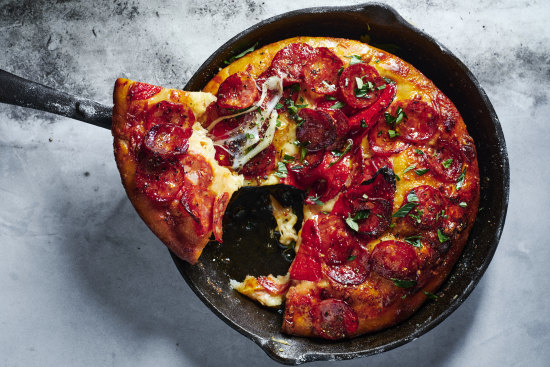
Get the weekend started in style with this deep-dish pepperoni pizza with a golden secret
Using store-bought pizza dough and loads of grated parmesan gives this American-style deep-dish pizza the perfect golden, cheesy crust.
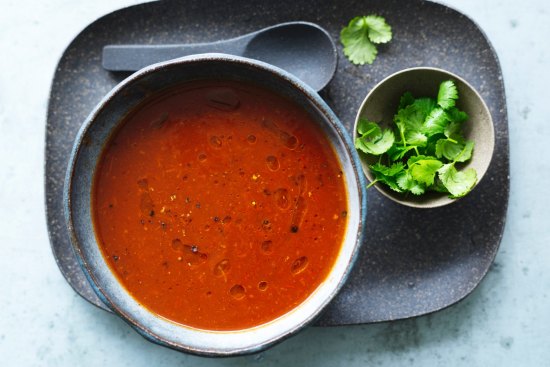
Tomato shorba
Put a little restraint into your diet without sacrificing flavour.
Previous
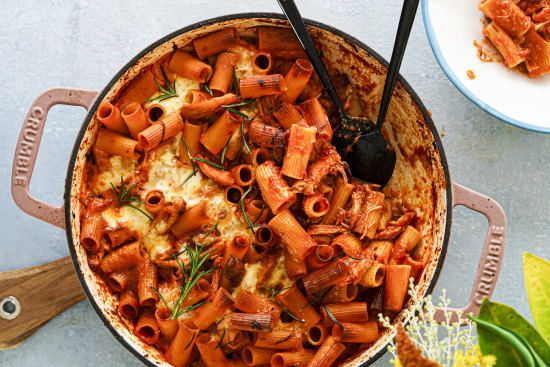
Chicken and vodka pasta bake
A touch of vodka brings depth to this glorious chicken pasta one-pot wonder.
The best recipes from Australia's leading chefs straight to your inbox.
Sign upMore:


